Pakistan
1 Chapter Basic knowledge
-
-
1 Chapter Basic knowledge
2 Chapter Investment Environment
2.2 Investment regulation and incentives
3 Chapter Establishment
3.1 Characteristics of business base
3.3 Company liquidation and withdrawal
4 Chapter Corporate Law
4.4 REGULATORY BODY/BODIES AND AFFILIATED INSTITUTIONS
5 Chapter Accounting
5.1 Accounting system in Pakistan
5.2 Disclosure system of Pakistan
6 Chapter Tax
6.2 Individual Issues in Pakistan Domestic Tax Law
7 Chapter Labor
7.4 Points to keep in mind while having Japanese people in Japan
-
-
-
Basic knowledge
■ Formal Country ➡ Pakistan / Islamic RepublicEnglish name: IslamicRepublicofPakistanUrdu:یمالساہیروہمجکاپناتس
"Pakistan" means "a clean country" in Persian. It is also said to originate from the five major regions and Muslim states that make up Pakistan called Punjab, Afghania, Kashmir, Islamic, Sind, Balochistan .In English-speaking countries etc., the word "paki" is sometimes used as a derogatory term, so you should avoid abbreviating the country name and calling it "paki".
National flagThe flag of Pakistan is a flag whose white crescent and star was designed in the green area. Originally designed in 1906, it was officially enacted at the time of independence in 1947. Green is a color symbolizing Islam, white indicates the existence of minorities other than Muslims, crescent moon indicates progress, star shows light and knowledge.
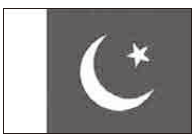
■ Area · Country ➡ 796,096 ㎢ (about 2.1 times the size of Japan)In the north there are the Karakoram Mountain Range and Hindukishi Mountain Range, also known as the world's roof, with high altitude mountains such as K2 (altitude 8,611 m) and Nanga / Parbat (altitude 8,126 m). In the Afghanistan side the Kaibaru Pass, the Indian side border the Tar Desert, and the south the Kachi Great Plains spread. From the north to the Arabian Sea, the Indus River flows so as to traverse the national land.
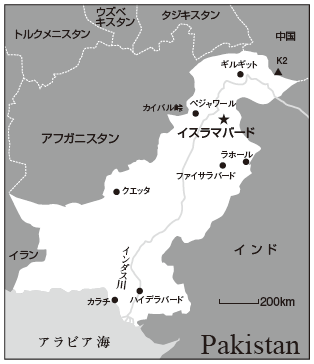
■ Capital ➡ IslamabadEnglish: Islamabad Urdu: مالسادابآThe population of Islamabad is about 14,790,000 people (2014), and the population of the urban area is about 69.87 million (2 0 14 years).■ Climate ➡ temperate summer rain climate, step climate, desert climateThe climate of Pakistan is roughly divided into three: the temperate summer rain climate in the northern mountainous region, the step climate in the north, and the desert climate in the south. There are four seasons, three to May in spring, June to September in summer, October to November in autumn, and from December to February in winter. Annual rainfall is as low as 250 ~ 1,250 mm, but most is brought about by the southwestern monsoon breeze blowing at the end of summer, flood damage has occurred many times due to the effects of concentrated torrential rainfall.
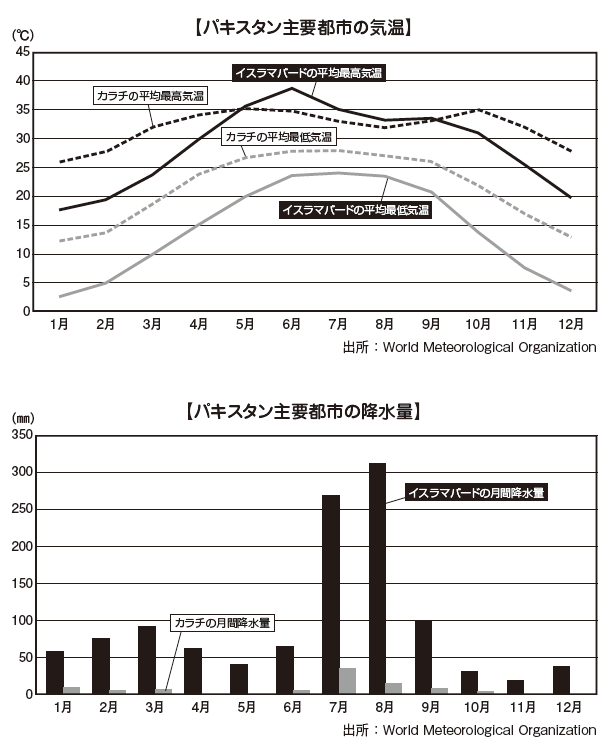
■ Time difference ➡ - 4 hours (UTC: + 5: 00)Pakistan is four hours later than Japan. In other words, when Japan is at noon, it is 8 am in Pakistan. Daylight saving time is not introduced.
■ Population ➡ 191.1 million (estimated in 2014)The population proportion of each race is the highest at 45% for Punjabians, then 15% for Pashtun and 14% Sindh.
■ Language ➡ Urdu (national language), English (official language)Population proportion by language is 48% in Punjabi, 12% in Sindhi, 10% in Saraik, 8% in Pashto, 8% in Urdu, 3% in Barrochi, 2% in Hindko and 1% in Burafui and 8% in others It is getting.Urdu is regulated as a national language, but as mentioned above, only 8% of Pakistani people speak Urdu as their mother tongue. Therefore, official language English is used in official documents and most ministries and agencies.
■ Currency ➡ Pakistan RupeeThe types of coins are 5 Pisa, 10 Pisa, 25 Pisa, 50 Pasa, 1 Rupee, 2 Rupees, 5 Rupees, Banknotes are Rupees 5, Rs 10, Rs 20, Rs 50, Rs 100, Rs 500, Rs 1,000, There are types such as 5,000 rupees, but Paisa is currently almost out of circulation. The exchange rate is 1 PKR = about 1.16 yen as of November 2015.
■ Religion ➡ MuslimThe population proportion is 95% of Islam (75% of Sunni group, 20% of Shi'a group) and 5% (including Christianity and Hinduism) of other.Freedom of religion is not guaranteed, such as withdrawal from Islam, marriage between Muslim women and non-Muslim men, and blasphemy against Islam and Muhammad, etc. are prohibited by laws and regulations, religious discrimination There still exist. Also, you will receive censorship on foreign religious books and the Internet.■ Main history of Pakistan1947 Independence from British India, First Primary Mark War1948 "founding father" Jinna died1952 Nippon Diplomatic Foundation established1956 promulgated and enforced the "Constitution of the Islamic Republic of Pakistan" (parliamentary cabinet system)A coup d'etat by General Army Ayub Khan in 1958. Ayubu Khan Army general, inaugurated as President1962 Pakistan Republic Constitution (Presidential System) promulgated and enforced1965 Second India war war1969 President Ayub resigned, Yahya Army chief of staff, appointed presidentFirst election held in 1970In 1971, the Third Printing War Paper (East Pakistan Is Independent as Bangladesh), Inaugurated Z.A.But People's Party (PPP) President1973 Promotion and enforcement of the "Constitution of the Islamic Republic of Pakistan" (parliamentary cabinet system), appointed Prime Minister of Z · A · BhuttoExecution of the general election in 1977, Coup by Hack Army chief of staff1978 Hack Army Chief of Staff, appointed PresidentPresident Huck started 1979 "Islamicization policy"1985 general election held, appointment of Prime Minister Genezo, 'Constitution's 8th amendment' was establishedPresident Huck dismissed Prime Minister Hack, dismissed Prime Minister Genezo, President Huck, died of a crash accident on a military flight attendant, appointed President G. I. Khan, took over as general president, elected general election, assumed Prime Minister B. Butt administration)President G. I · Kahn in 1990, dismissed Prime Minister B · Butt, implemented general elections, assumed Prime Minister Sharif (First Prime Sharif)1993 President G · I · Khan dismissed Prime Minister Sharif, implemented the general election, assumed Prime Minister B. Butt became the second Prime Minister of BhuttoPresident Regare in 1996, dismissed Prime Minister B. ButtExecution of the general election in 1997, Prime Minister Sharif took office (second Sharif regime)"Constitution's thirteenth amendment" was established1998 Pakistan Nuclear Test1999 Kargil conflict. Coup by Musharraf Army General Chiefs of Staff, Musharraf Army Chief of Staff, appointed Chief Administrator2002 general election heldExecution of the 2007 presidential election, President Musharraf re-election, emergency declaration issuance2008 general election implementation, Gilani cabinet launch, President Musharraf resigning, inaugurated President Zardari2009 Ministerial Meeting of Friends of Pakistan and Organization of Supporting Countries MeetingHosting the Pakistan Donor Country SummitJICA and Pakistan Government announced an ODA loan agreement of ¥ 5 billion for large-scale flood disasters in 2010Pakistan minister assassination case in 2011Convicted in 2012 Gilani's prime minister for the first court contempt after foundingGilani's resignation, President Musharraf's re-election2013 Great Pakistan EarthquakeArrested Musharraf's entire president under treason treasonMamounne · Hussein assumed inauguration (Pakistan · Muslim Federation Nawaz · Sharif)School raid incident by the Taliban in 2014Marara Yusufuzai Mr. Nobel Peace Prize Winner2015 Norway-Philippine ambassador attack incident in 2015■ Political System ➡ Federal RepublicHead of state: President Ashir Ali ZardariDiet: Bicameral systemThe Senate has a capacity of 100, a term of 6 yearsThe House of Representatives has a capacity of 342 people, a term of 5 yearsThe main political parties are the Pakistan Peoples Party (PPP), the Nawaz School (PML-N) of Pakistan Muslim League (PML), the Kaide-Azam School (PML-Q: Quaid-e-Azam Muttahida Majris-i-Amal), the Muttahida Qaumi Movement (MQM), the Musical Instruments Movement (MMA), the Musical Instruments Movement (MML), the Junior Joe School (PML-J), the Functional School (PML-F or Pagaroism) It is the Awami National Party (ANP).
■ Political / economic trendsSince the independence of Pakistan government has been through the parent rail since independence, but since the president Musharraf (then), who was a flag of the parent school, resigned in 2008, its parent rice line has been reviewed recently. In addition, there are moves to deepen relations with China, and a change in foreign policy is a glimpse.In terms of economy, in addition to the weakness of traditional economic infrastructure, we have suffered from domestic political conflicts and low foreign investment. Despite this situation, despite the fact that infrastructure such as a serious power shortage has not yet been established, between 2004 and 2007, GDP growth rate in the range of 5 to 8% has been achieved and worldwide attention I gathered. However, due to changes in the international environment, the growth rate slowed during the 2008 - 2009 year, and the unemployment rate also rose. After that it is regaining stability, and now it is growing 3-4%. On the political side, however, assassination and confinement of terrorism and cabinet members continue from 2010 onwards, and in 2013 many issues remain, such as the rejection of state treasure against the current Prime Minister Zarari. In 2014, Mr. Marala Yusufuzai was awarded the Nobel Peace Prize, but in 2015 terrorism continues, including Norwegian and Philippine ambassadors being killed.
■ Number of Japanese residing in Japan861 (Statistics by Ministry of Foreign Affairs of 2010)
■ Politics of Pakistan[Internal affairs]Pakistan's domestic politics is traditionally known for its strength in the military. The coup d'etat has been repeated since independence, and the stable regime has not been maintained. It is a repetition of the phenomenon that it temporarily stabilized by dictatorship after coup d'etat, stabilized instantaneously with democratization, and eventually a coup occurred. Excellent talent in Pakistan tends to choose the military in the direction of career, the reliability to the democratic regime is not so high compared to the military regime. The confrontation between political parties is intense, and participation and withdrawal from the coalition government will be repeated.In the May general election in May 2013, the PML party, the leader of Nawaz Sharif, occupied a majority (190 seats out of 342 seats) by itself, and decided to hold the administration for the first time in about 14 years. And in September 2013 after that election, Mamounne Hussein is taking office as president. The regime is promoting the improvement of electricity supply and privatization of state enterprises in the country, strongly pushing out eradication of terror as a foreign policy, and is searching for restoration of relations with India and the United States.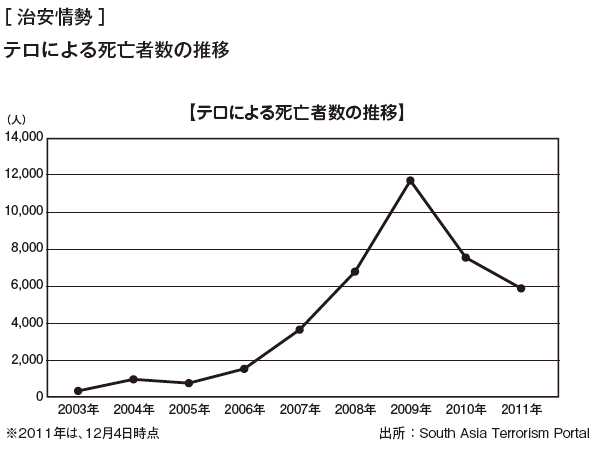 Since the security situation worsened seriously since 2007, the number of terrorist attacks has remained at a high level and in 2000 the death toll from terrorism became the worst of 11,04 in the past. Although it decreased thereafter, in FY 2011, more than 5,000 deaths have been issued.Terrorist attacks targeting security officials in Pakistan such as Pakistan-Taliban Movement (TTP), such as Pakistan-Taliban Movement (TTP) and other security officials in Karachi city and others, and terrorism aimed at foreigners are occurring frequently in Pakistan, The number is over 1,500 annually.Especially since 2007, military sweeping operations against these forces, mainly in the northwestern part, have been implemented, retaliation and terrorism are intensifying, and in June 2014 TTP will be transferred to foreign investors and multinational companies We have issued a warning statement to stop and withdraw from commercial activities in Pakistan.The trend of the number of deaths due to terrorism since 2009 is as follows. The number of deceased people is decreasing. However, terrorism against government officials, ambassadors, and children is continuing.
Since the security situation worsened seriously since 2007, the number of terrorist attacks has remained at a high level and in 2000 the death toll from terrorism became the worst of 11,04 in the past. Although it decreased thereafter, in FY 2011, more than 5,000 deaths have been issued.Terrorist attacks targeting security officials in Pakistan such as Pakistan-Taliban Movement (TTP), such as Pakistan-Taliban Movement (TTP) and other security officials in Karachi city and others, and terrorism aimed at foreigners are occurring frequently in Pakistan, The number is over 1,500 annually.Especially since 2007, military sweeping operations against these forces, mainly in the northwestern part, have been implemented, retaliation and terrorism are intensifying, and in June 2014 TTP will be transferred to foreign investors and multinational companies We have issued a warning statement to stop and withdraw from commercial activities in Pakistan.The trend of the number of deaths due to terrorism since 2009 is as follows. The number of deceased people is decreasing. However, terrorism against government officials, ambassadors, and children is continuing.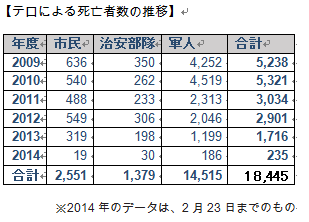
[Relations with foreign countries]Relations with JapanThe relationship with Japan, in particular because there was no history of conflicts, was generally good since the establishment of diplomatic relations in 1952. Pakistan's nuclear test showed that there was a time when grant aid was temporarily suspended but President Musharraf came to Japan in 2002 and then Prime Minister Junichiro Koizumi became Japan's prime minister in April 2005 for the first time in five years When I visited Pakistan, financial assistance resumed.However, looking at the trend of companies, the investment amount from Japan is only a small amount for economic scale. This is probably due to the fact that in addition to traditional unstable politics and inflationary economy, corporations can not step forward as security deterioration in recent years.
Relations to IndiaBoth Pakistan and India both underwent colonial rule from the UK, and at the time of independence in 1945, the present India and Pakistan were one India and the same India. However, Muslims are mostly Pakistan and Hindus are not able to resolve the conflict by the vast majority of India, and in 1947 Pakistan will separate in the form of independent separation.Although Gandhi worked hard to fill the gap between the two countries, it was assassinated on the grounds that the Hindus' extreme right young man is "a traitor who has Muslim shoulder."
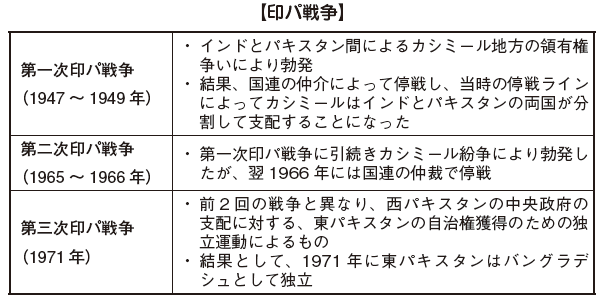 In November 2011, Markpa relationship showed great progress. The Government of Pakistan decided to grant MFN treatment to India. Despite persistent opposition in Pakistan, it seems that priority was given to economic recovery by expanding trade with India, where economic growth is remarkable.Potential trade value is said to be more than US $ 10 billion, and India has the potential to become a huge export partner. For local Japanese companies, it will also affect South Asia strategy.
In November 2011, Markpa relationship showed great progress. The Government of Pakistan decided to grant MFN treatment to India. Despite persistent opposition in Pakistan, it seems that priority was given to economic recovery by expanding trade with India, where economic growth is remarkable.Potential trade value is said to be more than US $ 10 billion, and India has the potential to become a huge export partner. For local Japanese companies, it will also affect South Asia strategy.
Relations with the USAs mentioned earlier, while the parent railway line was being revised by President Musharraf's resignation, the relationship between America and Pakistan became more chilly due to the killing of bin Laden.In Pakistan domestically, it is a US infringement of sovereignty against Pakistan that the United States did a military operation without prior notice, strengthening distrust of the fact that the Pakistani erupted in succession by the US military.Even in the United States, allegations arise that Pakistan is conspiring with Al Qaeda from the fact that Bin Laden was hiding in Pakistan.On the other hand, economic ties are still strong, and since the September 11 terrorist attacks in Pakistan, Pakistan has gained huge support from the United States and its amount reaches as much as US $ 20 billion in total.Recently, it is rapidly approaching China, showing a movement to check the United States, but the possibility that the relationship between Pakistan and the US will suddenly get cold is considered to be low. For Pakistan, the massive aid of the United States is an important source of funds, and for the United States, it is essential for the United States to secure influence and cooperate in the Afghanistan policy. In fact, Clinton 's Secretary of State in the United States visited Pakistan and agreed to restore the cold relationship by talks with President Zardari and others, and we are beginning to show the movement to restore relations.
[Relations with China]The Chunpa relationship begins with the mutual visit of the prime ministers of both countries in 1956. Originally we had a friendly relationship but we are in a state of cooling as a result of having joined the Manila Treaty led by the United States and taking a parent railway line with the United States to sign a "joint defense agreement". did.However, in the 1960 's, relationships changed completely as a result of border disputes between India and India. It is because America supported India. With this, Pakistan will deepen its relationship with the former Soviet Union and China. He showed support for China's return to the United Nations and permanent membership of the Security Council and played a role as an intermediary between China and Islamic countries.Even after entering the 2000s, the two countries have maintained close ties. In particular, China consulted on the establishment of a Chinese naval base in Pakistan and agreed to supply more than 50 F-17 fighter planes from China to Pakistan and China is the largest military supplier for Pakistan It is getting.Also, in terms of economic ties, investment of 30 million yuan for flood damage in Pakistan was carried out in September 2011, and investment from China is being activated in the Pakistan controlled area of the Kashmir region. The relationship with China that is said to be "all-weather friendly relations" is indispensable for the future development of Pakistan.
■ Religion in PakistanPakistan is dangerous that Muslims are violating their own interests against Hindus when India is independent from the UK, and has been more independent than India. For that reason Islam color has been very strong since the beginning of the founding of the country, and the president is also selected from Muslims in the generations.This is not an unwritten law as a foreign country like a foreign country, it is stipulated by the explicit provision, and its discrimination provision still exists. There are also laws prohibiting criticism of Islam, Koran, Muhammad, and laws prohibiting marriage of Islamic women and non-Islamic men. It sometimes happens that the death sentence will be declared as insulting Islam.Thus, in talking about the country Pakistan it is impossible to avoid discrimination against Islamic monopolistic systems and other religions. Regardless of the theoretical pros and cons of this religious inequality, understanding Muslims is indispensable when working in Pakistan.Also in Islam there is a confrontation between Sunni and Shi'a, sometimes crash and casualties that will result in casualties and terrorism also occur, so we can not approach places where religious events are held or places where unspecified people gather We need self-defense measures such as.
-
-
-
Economy
■ OverviewSince Pakistan's economy has played a major role in the agricultural sector since the establishment of the country, especially in the 1960s and 1980s the GDP had been at a relatively high growth rate with an average GDP of around 5% due to the rise in productivity due to the green revolution . However, in the following 1990's, the growth rate has stagnated due to the increase in defense expenses and the sense of political obstruction, sometimes being said as the lost decade of Pakistan.In the 2000s, the growth rate of the industrial sector and the service sector showed favorable figures of GDP growth rate in the range of 5 to 8% from 2004 to 2007. However, due to political turmoil, foreign economic turmoil, international oil prices, soaring food prices, expanding budget deficit, etc., will greatly slow economic growth, the unemployment rate will also rise and receive loans from the IMF .Since then, we have picked up due to food and fuel price falls, but the value of Pakistan Rupee has continued to decline as a result of political and economic instability. Also, there are still many uncertainties, such as the record flooding in 2001 hurt the agricultural sector and spurred the rise in inflation.The real economic growth rate in FY 2014 is 4.2%, maintaining the growth rate of 3-4% since 2010.In this way, the economy of Pakistan is getting strong with the prosperity of agriculture and industry, the political instability and the vulnerability of the economic infrastructure are stagnating in a way that pulls the feet and the potential development possibility Compared with the situation, it can be said that actual growth is not yet catching up.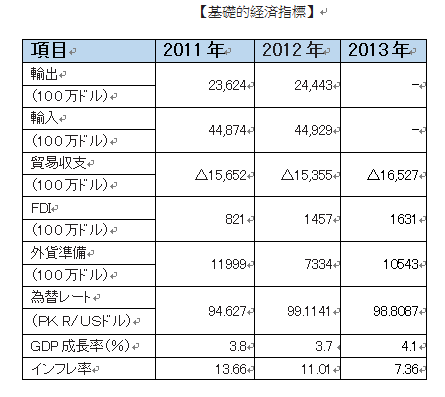
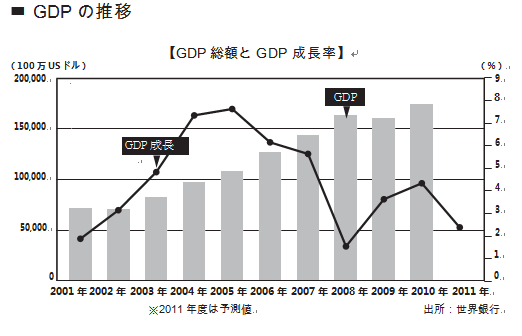 The total GDP (million dollars) and growth rate since 2011 will be as follows.
The total GDP (million dollars) and growth rate since 2011 will be as follows.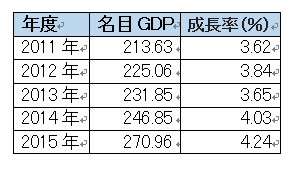
Pakistan is positioned as "NEXT 11" of Emerging Country Group next to BRICs, and future growth is promising in the world as well. However, it is also a fact that there are various anxieties.First is the prolonged economic slump caused by the flood in July 2010. Looking at the industrial structure of Pakistan, the percentage of workers engaged in primary industry is very high, about 44%, but the tertiary industry is expanding in recent years, wholesale and retail trade (18.6%), transportation · Continued with communication (13.0%). Meanwhile, the manufacturing industry remains at 13.5% of the total.Also, among the secondary industries, the major industries are the textile industry and the apparel industry, which are largely influenced by domestic cotton bad weather. It is thought that the market price of cotton rises due to the influence of cotton harvest reduction due to the flood, which causes a slump in the textile industry and the apparel industry, and as a result the growth of GDP is likely to slow down. The economic growth rate in 2011 fell to 2.4% due to floods and deterioration of security.There is also concern about an increase in the unemployment rate and sluggish consumption resulting from it. It is said that 14% of Pakistan's arable land has been damaged due to the flood, and it is also difficult to plant it due to floods. Under such circumstances, the unemployment rate may deteriorate.In conclusion, the key point in forecasting future GDP is how to weaken the relevance of agricultural sector and manufacturing department. In the current Pakistan industrial structure eventually the economic growth will be affected by the aggravation of the agricultural sector. However, it is difficult to expect stable growth of the agricultural sector because it depends on uncertain factors such as natural disasters, it is necessary to industrialize as much as can absorb this slump in this agricultural sector. To that end, it will be necessary to increase the investment from domestic and foreign sources, to implement stable policies and policies from a long-term perspective, but this situation is difficult to expect due to the deterioration of security.■ National financePakistan's budget deficit is increasing year by year. In 2010, it surpassed 600 billion Pakistan Rupee, which has nearly doubled in the past five years.Although it faced a serious economic crisis in 2008, the International Monetary Fund (IMF) lent more than 10 billion yen in total, and the crisis level was out. However, since the budget deficit has continued to expand and it has become impossible to satisfy the loan terms, the loan from the IMF was stopped in 2010.In order to secure the tax revenue base, the current administration has been trying to stabilize the fiscal situation by eliminating exemption from sales tax in the agricultural field and increasing taxes on special excise taxes, but this has not yet been resolved.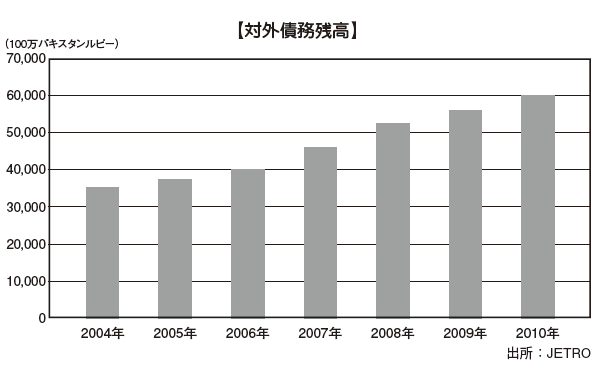 The outstanding debt outstanding ($ 1 million) and growth rate since 2011 are as follows. In addition, in the Pakistan Economic White Paper in 2013/14, the outstanding accumulated debt outstanding has been announced to have reached 8,811.1 million dollars.Foreign responsibility balance 2011 2012 2013(1 million dollars) 65, 478 59, 779 65, 606
The outstanding debt outstanding ($ 1 million) and growth rate since 2011 are as follows. In addition, in the Pakistan Economic White Paper in 2013/14, the outstanding accumulated debt outstanding has been announced to have reached 8,811.1 million dollars.Foreign responsibility balance 2011 2012 2013(1 million dollars) 65, 478 59, 779 65, 606
■ Migrant workersAn important factor supporting the Pakistan economy is remittance from migrant workers. Remittances from overseas workers, mainly in the Middle East, have become a valuable source of foreign currency for the nation.The amount continues to increase year by year, and it was US $ 1.21 billion in 2010 - 11, compensating for the trade deficit and contributing to the surplus of the current account surplus.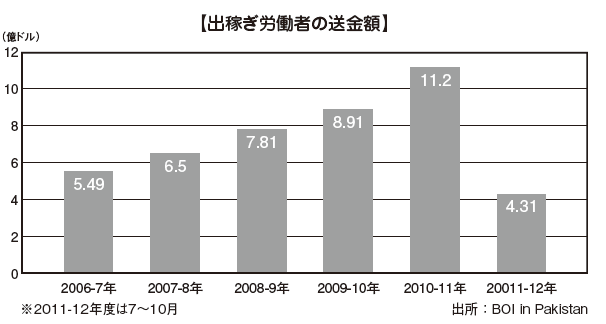
However, there are concerns that it leads to the outflow of human resources. Because domestic workers can only work in low wage positions, it is said that excellent people tend to work abroad and return to Pakistan is rare. In the Philippines, there is a precedent that the domestic industry is stagnating due to the similar problem, so urgent solutions are required. In any case, it is no doubt that remittances to migrant workers to Pakistan have supported consumption and contributed to economic growth.Moreover, the trend of remittance amount of migrant workers (1 million US dollars) since 2011 is increasing as follows.【Transfer amount of migrant workers (US $ 1 million)】Year 2011 2012 2013 2014Transfer amount 12, 263 14, 010 14, 626 17, 060■ Amount of tradeInternational trade in Pakistan suffers from enormous deficits due to declining exports. Domestic political instability also spurs the trade deficit. The trade deficit in 2013 has expanded to US $ 16,527 million. It should be noted that Pakistan is a member of the Economic Cooperation Organization (ECO), the South Asian Free Trade Area (SAFTA), the World Intellectual Property Organization (WIPO) and the World Trade Organization WTO: World Trade Organization).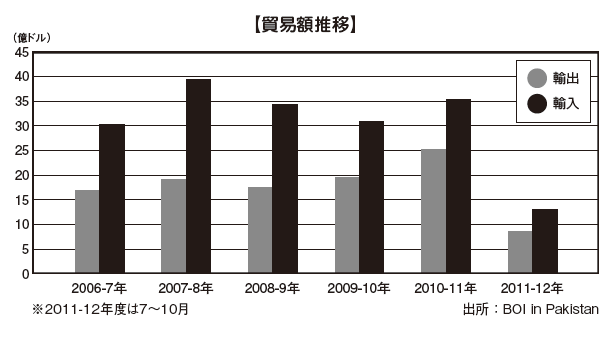
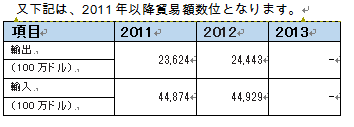
■ Export amountBy product, fibers and products account for about 50% of the total, which is a major export item. In addition, overall foods were strong, and meats increased mainly for Saudi Arabia.By country, the US will reach US $ 3.545 billion (15.6%) in 2012, China will reach 2,483 million USD (10.9%), 2012, followed by United Arab Emirates and the UK. Especially the increase in exports to China is noticeable.Since 2011, exports to Afghanistan and the United Arab Emirates are also steady, and Pakistan is taking a role as a gateway to Central Asia. While Bangladesh is becoming a major gathering industry in the sewing industry, imports of cotton, which is raw material, depend on imports, and imports from Pakistan are increasing with the expansion of production. This trend is expected to continue in the future.Exports and imports increased slightly in 2011 and 2012, and there are no special items to be noted.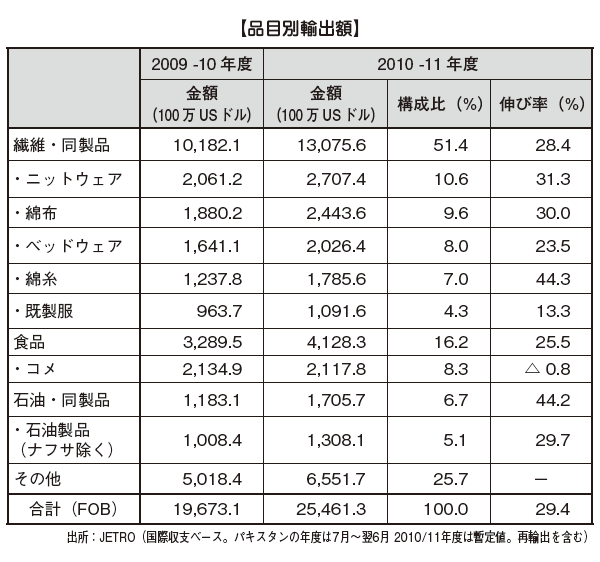 The figures after 2011 - 2012 are as follows.
The figures after 2011 - 2012 are as follows.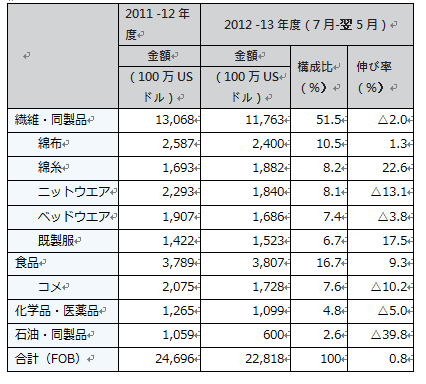
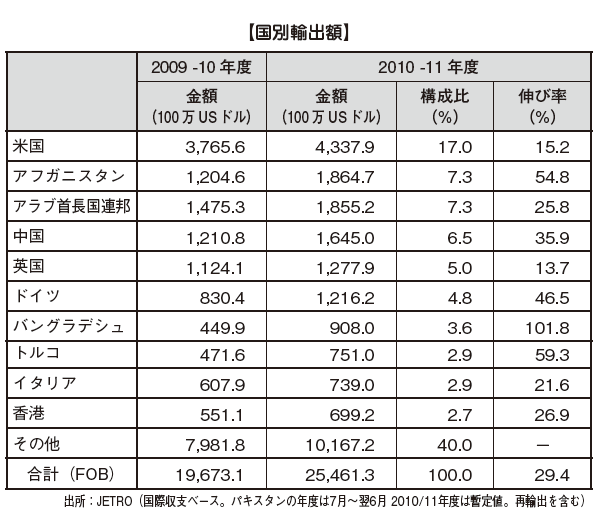 The figures after 2011 - 2012 are as follows.
The figures after 2011 - 2012 are as follows.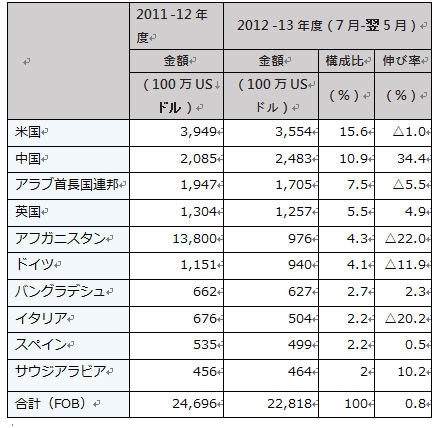
■ Import valueBy product, we will continue with petroleum products, chemical products, foods. Regarding chemical products, chemical fertilizers fell 47% year on year, largely due to agricultural decline due to floods. Imports of textiles, crude oil and related goods have greatly increased since fiscal 2011, while imports of transportation equipment, foods, palm oil, etc. are declining.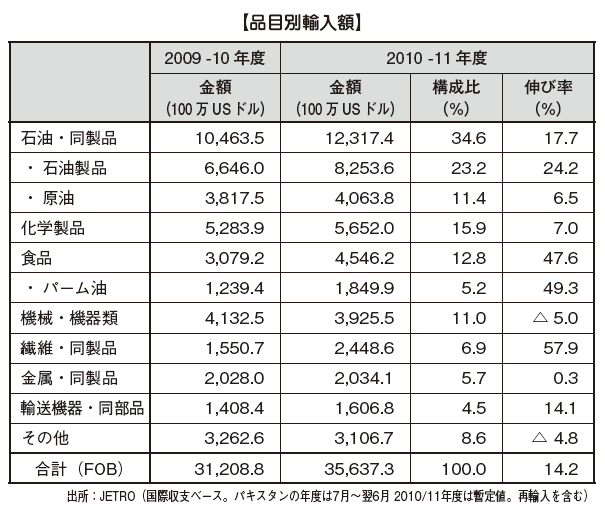 The figures after 2011 - 2012 are as follows.
The figures after 2011 - 2012 are as follows.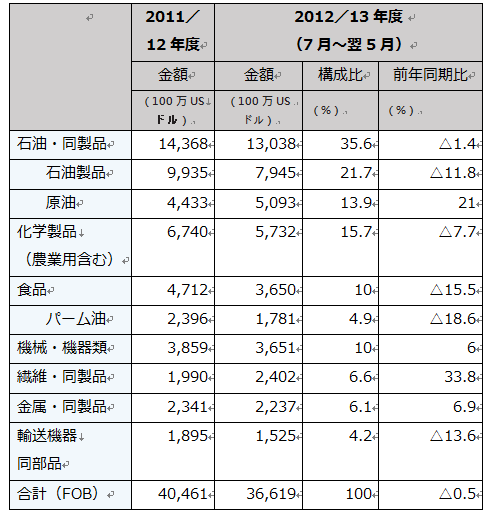 By country imports, Middle Eastern countries will be the center. The top ranked are the United Arab Emirates, 5,789 million US dollars (15.8%), China ranked second with 4,316 million US dollars (11.8%), third place Saudi Arabia 3,7 29 million US dollars (10.2%), , Kuwait, Singapore and so on.
By country imports, Middle Eastern countries will be the center. The top ranked are the United Arab Emirates, 5,789 million US dollars (15.8%), China ranked second with 4,316 million US dollars (11.8%), third place Saudi Arabia 3,7 29 million US dollars (10.2%), , Kuwait, Singapore and so on.
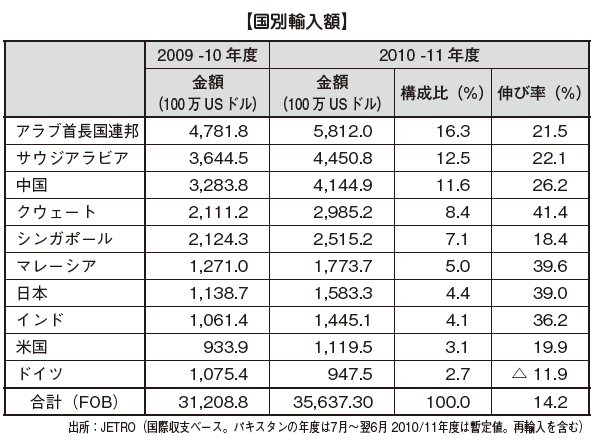 The figures after 2011 - 2012 are as follows. ]
The figures after 2011 - 2012 are as follows. ]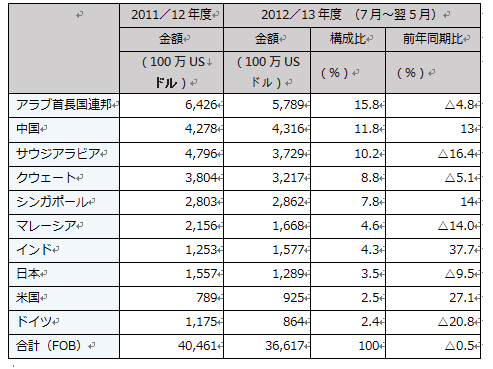
■ Trade with JapanThere is no big change in trade with Japan compared to trade with other countries over the last few years. Cotton yarn, which is the main export item of Pakistan, is increasing overall, but the export value to Japan has declined since 2010. On the other hand, petroleum and petroleum products have grown significantly, and in 2010, it accounts for 46% of the total.From Japan, we export mainly mechanical equipment for industrial use.
 The figures after 2011 - 2012 are as follows.2011 year 2012Export value to Japan 202 166Import value to Japan 1,918 2,061
The figures after 2011 - 2012 are as follows.2011 year 2012Export value to Japan 202 166Import value to Japan 1,918 2,061
[Main item (2013)]Export to Japan: petroleum products and copper products, yarns and textiles for organic compounds / textiles, nonferrous metals, clothing and accessoriesPetroleum products and copper products: 15,366 million yen (33.16%)Organic compound: ¥ 8,843 million (19.08%)Textile yarn and textile products: 7,437 million yen (16.05%)Nonferrous metals: 4,342 million yen (9.37%)Clothing and accessories: 2,590 million yen (5.59%)
Imports to Japan: Transportation Prize Equipment · General Equipment · Steel · Electric Equipment · Plastic
Automobiles and parts thereof: 49.85 billion yen (35.87%)General machinery: 32,642 million yen (23.49%)Steel: 21,699 million yen (15.61%)Electrical equipment: ¥ 11,530 million (8.2%)Plastics: 2.87 billion yen (2.06%)Industry structureLooking at the industrial structure of Pakistan, we can see that the proportion of primary industry still accounts for 20% and industrialization has not progressed. Infrastructure development has not progressed quite well, and nearly half of the people are engaged in agriculture, making it an unstable industrial structure.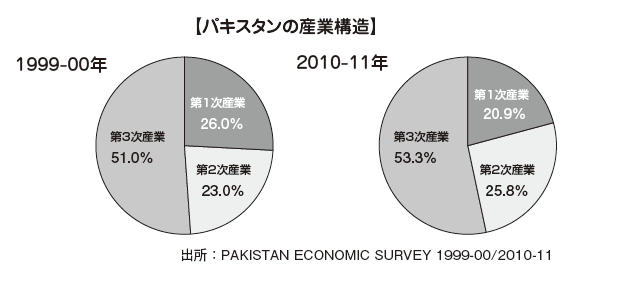 The figures for fiscal 2013 (real GDP composition ratio) are as follows.
The figures for fiscal 2013 (real GDP composition ratio) are as follows.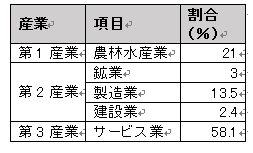
[Primary industry (Agriculture)]The primary industry in Pakistan plays a major role in the economy of the country. Approximately 44% of the workforce is engaged in agriculture in fiscal 2013, accounting for 21% of GDP in 2014. According to the UN Food and Agriculture Organization 's announcement in 2013, Pakistan produces chickpeas the third largest in the world, and the mango production is the world' s sixth. Other major agricultural products are onion, cotton, rice, mandarin orange, apricot, sugar cane, date palm, clementine, wheat etc. In the production of cotton, it is the fourth largest in the world.
[Secondary Industry (Manufacturing Industry)]In Pakistan's manufacturing industry, about 20% of the country's workforce is engaged. The main industries are cotton fiber and apparel manufacture, carpet, rug, rice, chemicals, sporting goods and leather goods, construction materials, minerals, paper products, food processing and drinks etc. Fibers and clothing make up about half of the country's exports and play an extremely important role. The secondary industry sector was the driving force of the economic boom in the first half of the 2000s, but due to inadequate infrastructure such as power shortage and political unrest, investment from overseas will not proceed at present.
[Third Industry (Service Industry)]The service industry in Pakistan accounts for about 58% of GDP, financial, insurance, transportation, communications, storage, etc. are the main industries. Wholesale and retail trade accounts for approximately 18% of GDP. With the increase in software exports, the IT industry has emerged as a prosperous service industry. In addition, the Pakistan government is actively involved in the privatization of banks, communications and utilities.
-



 Japan
Japan UnitedStates
UnitedStates China
China Hong Kong
Hong Kong Mongolia
Mongolia Russia
Russia Thailand
Thailand Vietnam
Vietnam Laos
Laos Cambodia
Cambodia Myanmar
Myanmar Indonesia
Indonesia Philippines
Philippines Singapore
Singapore Malaysia
Malaysia India
India Bangladesh
Bangladesh Pakistan
Pakistan Sri Lanka
Sri Lanka Mexico
Mexico Brazil
Brazil Peru
Peru Colombia
Colombia Chile
Chile Argentina
Argentina DubaiAbuDhabi
DubaiAbuDhabi Turkey
Turkey South Africa
South Africa Nigeria
Nigeria Egypt
Egypt Morocco
Morocco Kenya
Kenya